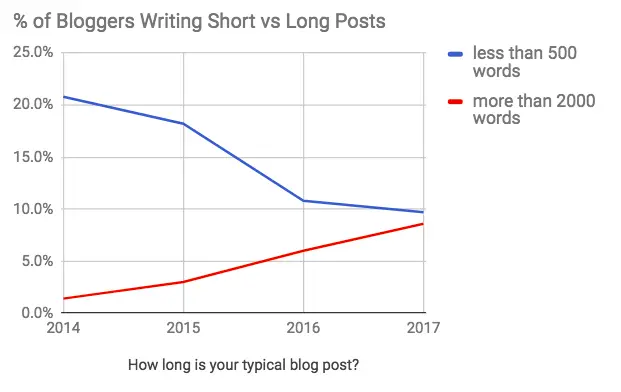Is Content Marketing A Good Investment for Small Businesses? Plus Tips & Advice
One of the greatest things about starting a new business is working with a clean slate. A chance to build things on strong foundations from day one. For many new businesses, their online presence is paramount to their plans and successes. Regardless of whether you’re most interested in website traffic, social media shares, blog coverage or thought leadership opportunities, you’re going to need content.
Content Marketing is a huge field of marketing and it’s growing rapidly. It is recognised by businesses large and small across the world as a key driver of online activity. 78% of marketing decision makers believe content is the future of their industry. Exciting stuff.
However, there is both an upside and a downside to the content revolution, and business owners should be aware of this before deciding if Content Marketing is right for them.
The Upside of Content Marketing
When Content Marketing is working for you, it can really pay off.
In the Social Media space, your content can get shared far and wide, and with it, your brand. You can reach and engage audiences who otherwise would never have been introduced to your brand.
From a website point of view, you can drive significant volumes of free traffic through Google. Who wouldn’t want that?! And not just numbers for number’s sake. By delivering content which serves the needs of potential customers, you can directly increase sales and enquiries.
What’s more, the internet is a crowded place. Trying to appear in search engines for money-keywords like “pizza delivery”, “cheap laptops” or “divorce solicitors” is going to be tough. However, with Content Marketing, you can be more specific in your keywords and target less competitive phrases like “is it worth buying a cheap laptop” or “how much do divorce solicitors charge”. Such phrases are known as “long-tail” keywords.

Source: How To Drive Content Marketing Using Long-Tail Keywords
Whilst the above snapshot shows a decline in monthly searches for “long-tail” keywords, there are countless variations of phrases that people search for. Keyword experts, Ahrefs have concluded that “long-tail” keywords represent 70% of all searches. For this reason and several others, Search Engine Marketers are more frequently using Content Marketing to drive their campaigns.
Content can convey so much more than just products and services.
Your content should not just be about what you do or sell. It should reflect the personality of the business, the purpose and vocation. That really matters. In fact, brand authenticity is considered the most important factor in a millennials decision to use your services or buy your products. It’s that important.
Your audience is not just interested in what you do, but why you do it. Your values make you unique and captivating. Through this, your customer will buy into your brand. You can build affinity around shared values, shared goals and your business ethos.
Take Red Bull for instance. They have emerged as a lifestyle brand through Content Marketing. They have a portfolio of over 5,000 action sports videos, 50,000 jaw-dropping images and several action sports live events which are broadcast online and on TV. Oh, and they also sell a drink, remember? Apple also famously sell a lifestyle. People buy the products because they’ve bought into the lifestyle that is associated with it.
The Unfortunate Downside of Content Marketing
For all the reason given and more, it’s really popular and therefore it’s a crowded scene.
To give you a sense of just how popular it is, WordPress, which powers 29% of the web, recently stated that 70 million blog posts are published every month through WordPress alone. That’s a lot of content and has risen dramatically in recent years.

Image Creds: BuzzSumo
This explosion has largely come around due to the hype. It is now pretty much standard for businesses to have blogs and be publishing articles regularly. That means that all of your competitors are doing it too.
Engagement is dropping
This stands to reason, after all, there are a limited number of readers to go around. As more and more businesses have become demi-publishers, the number of articles published has gone up, and engagement has declined as a natural by-product.

Quantity of Content vs. Engagement (shares) – Source
The bar keeps rising and with it, the required investment
Those “snackable” pieces that took just 30 minutes to throw together simply won’t cut it these days. Each year, surveys show that bloggers and Content Marketers are ploughing more and more time into each piece. Nearly 50% of bloggers are now spending 6+ hours per piece because longer pieces are said to produce better results.

Source: Why Today’s Bloggers Spend More Time Writing Less Content
There is arguably a plus side to this though. Less churn and burn equals fewer articles to compete with, so long as you can rival the quality.
Still Think Content Marketing Is for You or Your Business?
Good. We wholeheartedly recommend it. But before embarking on a Content Marketing mission, you needed to know the truth. There are no quick wins and low-hanging-fruit in Content Marketing land. There is no point winging it, whacking it up on the blog and hoping for the best.
However, there is a lot to play for and many reasons to justify investing in Content Marketing. It really is possible to drive strong growth and see great returns but to own this channel, you have to be strategic, dedicated and purposeful. It requires patience, investment, talent and infrastructure.
Your Content Marketing needs to run like a well-oiled machine.
Here are some ideas to whip your Content Marketing into good shape.
How to Make Content Marketing Work for You
Below, we have listed a range of ways to get serious about your content. Like most things, there’s no one single way to achieve great results, so we suggest picking those that best suit your business setup, and goals.
1. Take some ownership of your content
Maybe you’ve chosen to outsource articles to a freelancer or an agency, which is fine. But the chances are whoever is writing the content doesn’t know as much about your niche as you do. They’re probably relying on Google to research the topic and as a result, they’ll just be a regurgitating your competitors content.
So, if your content feels a bit tired and done already, then it’s time for you to step in. It’s easy to bridge the gap whilst still outsourcing, for example:
You have unique insight and industry knowledge:
- Hands on experience
- Up to date information
- Product knowledge
- Customer insights
Copywriters and agencies are typically experts in:
- Execution best practises
- Optimising for search, email or social
- Tone of voice
- Promotions
By combining both strengths, you can produce content that is original, best-in-class and authentic. So, get involved, suggest topics that your industry thrive on and offer your unique insights.
2. Remember quality, not just content length
You’ll see loads of advice about articles being over a certain word count. As mentioned, the industry is leaning towards “long-form” content, but there’s no right or wrong. It’s really down to the context and your goals. Regardless, “quality” usually means depth, therefore you probably need over 1000 words to convey anything meaningful.
But beware – there is a fine line between “long-form” and just loooooong and boring.
If you brief in 1000+ words, that’s what you’ll get. It doesn’t mean 1000+ good words! Typically, your brief will be on a pile of articles that a copywriter has to write, and they may want to get through that pile as quickly as possible.
To counter this, provide strong, clear briefs with loads of information. Make sure the emphasis is on quality and value to the reader. Length will come as a by-product of this.
3. Become content curators, not just writers
Who says you have to write all the content anyway? There are many ways to curate and manage content. For instance, you can leverage your networks and receive guest editorial. Even better than that, call upon other industry experts to weigh in on a debate and crowd-sourced commentary.
Obviously, you don’t want to be promoting competitors – we’re not suggesting that. The trick is to find a sub-topic that is relevant to your niche. For example, the Wedding Journal produced a guide to becoming a wedding planner using quotes from career planners themselves. Forde HR Cloud asked recruiters and business owners to offer tips on writing job descriptions. No competitors were mentioned in the creating of those pieces, yet there brimming with excellent, relevant, unique insight. Plus, you don’t have to pay for copywriting and contributors are often happy to promote the work.
A handy tip to get your expert round-ups off the ground is using the Twitter hashtag #JournoRequest or #BloggerRequest. Offer up a topic and ask if anyone wants to contribute. Easy as that.
4. Master Tone of Voice
A great way to make your content stand out is with a strong Tone of Voice which is unique to your business.
A great example is Craft Beer pioneers Brew Dog. Just read their about page. It’s brimming with passion and personality. You can immediately get a sense of who they are and why they do what they do.
Mastering Tone of Voice is actually quite easy, yet many larger, more established businesses struggle with this because it’s harder to do in retrospect. This, of course, gives your start-up the edge.
The process starts with knowing your “WHY”, something we talk about more in this blog post. Herein lies your Tone of Voice.
- What is your business passionate about?
- What matters to you?
- What are you communicating?
- Who are you writing for?
- What are their interests?
- What are their needs?
You don’t have to stand at the whiteboard for hours designing your Tone of Voice. Once you know what your business stands for, your content should ooze passion and your authenticity will resonate with your readers. That’s your Tone of Voice.
Incidentally, this is another reason why outsourcing can result is generic content. Your business is your passion, not some third parties. It’s hard to fake it. So work with authors who are as passionate and knowledgeable as you are.
5. Conduct original research
It’s fine to borrow stats and insights from other sources, but when your entire content strategy is based on regurgitating others, what are you really bringing to the table?
There are some great and affordable research tools and services out there that can ignite your content with original information. Here are two:
SurveyMonkey – A true classic, this platform has been around for ages. It’s easy to build surveys and then submit them to your networks, friends, colleagues or clients. However, it can be tricky to get them to take part, so keep surveys short and/or grease the wheels with a little prize draw.
OnePulse – This newcomer is making a name for itself as a quick, convenient and affordable way to produce micro-surveys. You can ask just three questions, but that’s great because it keeps your surveys really tight and focused. You can also target certain demographics and refine who responds to your survey. That said, this is better for consumer surveys than niche, professional surveys, so stick to lifestyle questions and current events, rather than trying to gain “expert” insights.
6. Don’t write about yourself or your company
Your company blog is an amazing marketing tool, so don’t fill it with self-promotional posts and internal memos. Your customers to be really aren’t interested in the inner workings of your office or what went down during that team building exercise. That type of content won’t drive traffic, leads or affinity. Your blog should showcase your expertise, be helpful, promote your causes, drive debate, share innovations, or just entertain.
If you must share information about internal promotions, client wins or Fridays bake-off challenge, set up a separate means.
7. Think short and long-term
You need to know what the ultimate goal is for Content Marketing and be dedicated to achieving it. Keeping your eyes on the prize will keep you motivated and enthused while you build your audience and traffic – which may take some time.
Meanwhile, you don’t want to lose sight of any interim progress made. So, it’s just as important to set milestones and celebrate them when achieved.
- Get 100 visitors from Google – bake a cake
- Get 50 email sign-ups – pizza for everyone
- Receive 10 comments on a single post – hire a bouncy castle (and have pizza)
- Discover a backlink from an industry leading publication – go to Disneyland (and have more pizza)
8. Pick a goal, any goal
All metrics are designed to show improvement (or decline) over time and by default, create accountability and a barometer of “what good looks like”. They all point in the same direction. Quality.
However, by focusing on a range of metrics, you be able to measure and improve your efforts in a multitude of ways so it’s worth monitoring many. Typical metrics include:
- Clicks from Google
To rank in Google, your content has to be of a high editorial standard and you will need to align content to keywords. This is good because you can use keyword data to create content that people are searching for.
- Number of comments
Comments are a great way to tell if your content is striking a chord with your audience. If no one’s commenting, then your content might not be engaging or emotive enough.
- Shares on social media
As above, your content has to appeal and matter to someone for them to share it on social media.
- Backlinks
If your receiving natural links, then your content is considered authoritative, which is the amber nectar of Content Marketing and worthy of a trip to Disneyland.
- Sign-ups
People don’t really like signing up to mailing lists. So, if they’ve signed up to yours, that means they trust you and see value in what you have to say. That’s pretty awesome.
- Leads/sales
To drive sales, your words have to resonate and fulfil a customer need. If you can see a tangible ROI from your content, that really helps justify increased investment too.
The Bottom Line
There is a lot of justified hype around Content Marketing, but it’s not a silver bullet. Those who have success have been doing it for years.
Whilst it takes investment and expertise to drive significant traffic and returns, it will drive incremental growth as it begins to flourish. Even at its most basic level, it’s worth doing as it encourages Google to crawl your site more regularly and it offers an opportunity to build additional internal links.
But, with a bit of determination, a good strategy, realistic expectations and by following some of the advice above, your business can drive significant and sustainable growth through Content Marketing.
It’s all good!
This post was contributed by guest author: Dave Clough

Dave Clough is a Digital PR & Content Marketing professional and owner of the LifeSupportMachine.co.uk music blog. He has a strong background in digital marketing having previously been the Natural Search Manager for Argos and worked in senior positions for numerous leading digital agencies in London.
Finally please social share and comment below…
If you enjoyed reading this article about ‘is content marketing a good investment for small businesses,’ please share. Choose your favourite social media channel below. I’d also appreciate your comments below too, and thank you for reading #inBizBlog.
Thanks, Tracey-Jane, I appreciate the response. You’re right, it’s not easy and it’s not particularly intuitive either. As a result, Content Marketing sometimes has an expectations and “mindset” challenge. I hope my little guide goes some way to helping someone 🙂
I love creating content, and reading others too Dave. I’m a real learner. I find that many small businesses struggle with the “what do I write about”, or “I haven’t got time”, mindset.
However, as you say, by creating a content strategy, even if it’s not spending a lot of time on this each week, a business will still benefit in the long term. I find that when a business makes the commitment to share what they do with their [potential] customers, they find that it’s simply them sharing what they do and know best & then their personality really shines through.
It’s not easy. But committing time to content marketing, as part of your overall marketing strategy, will make a difference.
Wow great post Dave! THANK YOU for talking about being authoritative and focusing on brand personality! So many people forget about this and it’s really puzzling because it should be the basis of why you create a blog, SEO and sales come later. I think many people just create a blog because they know they should be doing it, but I don’t really think they understand why.
Hi Alex, really appreciate the feedback – thank you too!